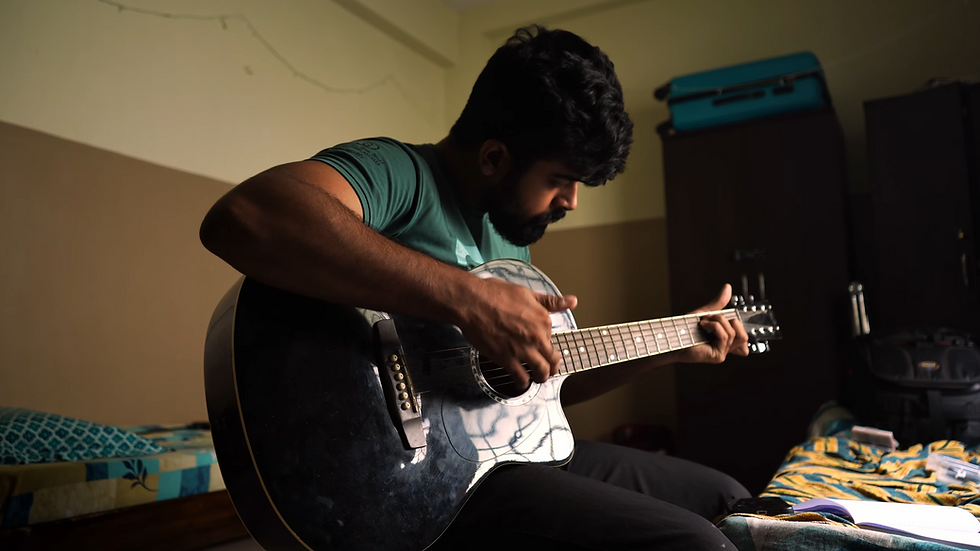Film Review: Boogie Woogie Blues
- Tokyo Cine Mag

- May 8, 2024
- 3 min read
By Pegah Tarkhooni

Boogie Woogie Blues, Directed by Mattia Vuono, begins with some aerial shots; a car driving on a narrow road lined with bare trees. The filmmaker gradually familiarizes us with the film's atmosphere. While watching these aerial shots of the car, the film provides us with information about the story through red expository intertitles on a black background (Somewhere in the middle of nowhere), indicating that we will likely be watching a silent film.
The film is shot in black and white with high-contrast and stylized lighting, following an expressionist style, alongside a superb musical score that has an unsettling, and nightmarish feel to it.
The film’s characters, a young girl and boy, are introduced to us in closed shots inside the car. The boy, with a rough and indifferent face, is driving on an empty road, while next to him, a girl with all the characteristics of a femme fatale is sitting, dangling her legs out of the car window. Up to this point, the film has been entirely black and white (except for the red color of the intertitles against a black background), and with the entrance of the girl, other red elements are introduced into the film (including red tinted glasses, red boots, and red lipstick she applies). The girl's face is completely covered, making it impossible for the viewer to identify her, adding to the mystery of her character and depriving us of a complete identification. The filmmaker emphasizes themes of paranoia and isolation by taking extreme close-up shots using skewed angles, framing, and unconventional angles. The young girl, with an emotionless face (or if any emotion is shown, it is one of satisfaction and contentment) reads a newspaper while biting into her red donut. Now we know we are facing a neo-noir genre film. Neo-noirs typically follow one or more anti-heroes who are set to expose a sinister conspiracy involving powerful criminals and corrupt systems.

Both main characters in the film are in an unspecified location; they are moving aimlessly on an unnamed road. Therefore, the road itself can be a central character for the viewer. Road cinema is a successful and popular film genre where the main protagonists leave their home and embark on a short or long journey from one place to another. They usually leave their homes to escape from their current situation and the predicament they are in. Road films serve as a means for individuals or small groups seeking escape from the world they live in, finding salvation and freedom along endless roads. The question arises as to who prefers to be on these roads more than others; strong and determined individuals or weak-willed ones? The appeal of road films lies in how the weak fall while the strong persevere and continue on their journey. However, from the darkest to the simple road films, they all share some similarities and common elements: a road and a convincing economic-social reason for travel mostly stemming from post-industrial society and discontent with the current situation. The young director Mattia Vuono reminds us of the characters' purpose of travel through proper arrangement of elements (as mentioned earlier), indicating that we are watching a chase film.

Without showing slightest emotions on their faces, The boy and the girl are fleeing from a situation they had planned for and now have hit the road, a place they belong to and where they feel safe and at ease. The filmmaker deliberately chooses smoky glasses for both characters in the film to conceal the emotions of the characters, or better to say criminals, and in this regard, the film has succeeded in portraying an emotionally empty scene for the viewer. Our only knowledge of these two characters is related to their printed image on the front page of the newspaper and reading the passing headline (“Wanted”).
The young director of the film has adhered to all the aesthetic rules of neo-noir in his short film and tried to stay true to all its principles. The result is a work that, in its short duration (2 minutes and 56 seconds), effectively reminds us of the genre it owes itself to. However, unlike other typical noir films that usually do not have happy endings, this one is different. Generally, in noir films, the ending is bitter and tragic, and the characters come to a predetermined conclusion. But in this film, the director prefers not to conclude his work with a definitive conclusion. Rather than ending with a conventional mournful tone typical of its genres, the film concludes with a sense of liberation, freedom, and satisfaction for the characters, as if the viewer had only been with the characters on a small, middle part of their journey and their ultimate fate remains unclear. A conclusion that must be imagined in accordance with what we have seen or, better put, with what has been shown to us.




















Comments